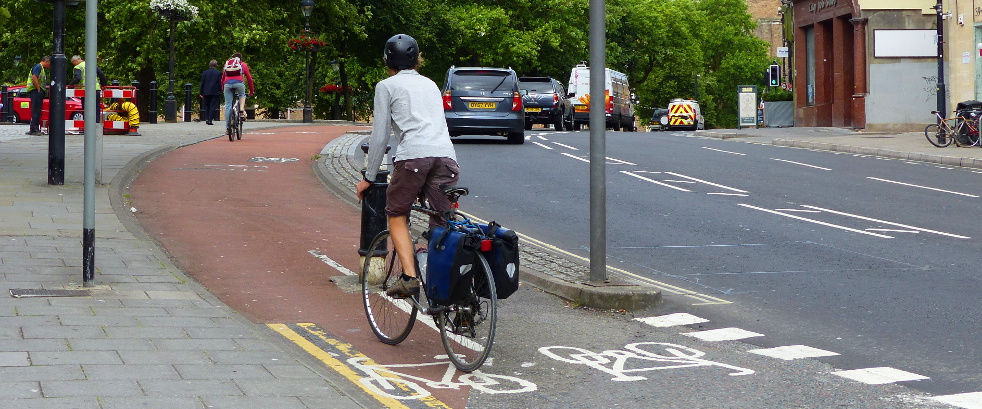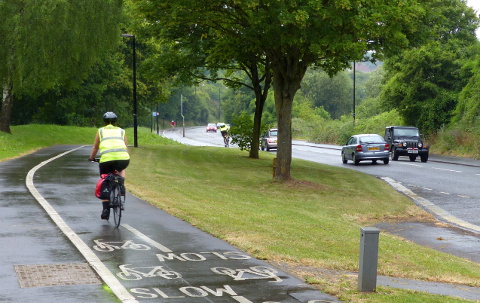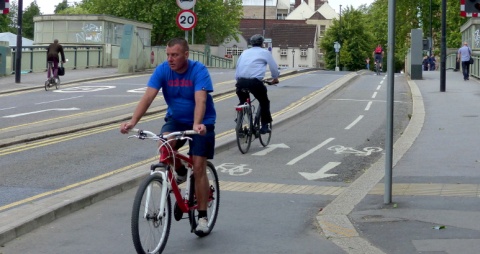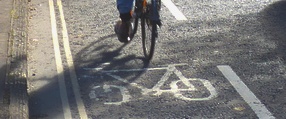Segregated Cycle Lanes

Segregated space allocates a section of the road for cycle use only. Some physical separation is used to stop motor vehicles from entering the space.
There are usually two lanes within the segregated space for each direction of cycle traffic, with bicycle symbols to show the lanes are for bicycles only. 'Give Way' symbols are often used when the lanes finish or come to a junction.

Disadvantages
- Costs considerably more than cycle lanes
- Only possible where there is enough space, or where it's possible to close one motor vehicle lane
- May leave less road space for motor vehicles and parking
Restrictions
- The road space must be able to accommodate a 3 metre motor vehicle lane, and at least 1.5 - 2 metres for the segregated cycle space
There's also some general restrictions to note for all schemes

Using Bollards
£20,000 - £50,000 with limited resurfacing£50,000 - £85,000 with bus stop relocation & resurfacing
Using kerbs
£45,000 - £75,000This scheme requires a Traffic Regulation Order
Advantages
- Allows cyclists and motor vehicles to travel without having to avoid each other
- Cyclists feel safer when they are not sharing the road with motor vehicles
- Offer better safety protection to cyclists compared to cycle lanes
- May encourage people to switch from using their car to cycling instead. This provides many benefits, including:
- Improving health of those choosing to cycle
- Reducing motor vehicle congestion
- Reducing pollution from motor vehicles

Effectiveness
Safety
There is very little evidence about the safety effects of segregated space. Overall, it is likely segregated space does improve safety for cyclists. Studies from Denmark have shown that segregated space reduces cyclists deaths by 35%.
It may seem obvious that removing cyclists from motor vehicle traffic will increase safety, however one study has suggested that when cyclists move out of the segregated space, there is an increase in accidents. This effect could potentially cancel-out any improved safety cyclists experience whilst within the segregated space.
Usability
For many people, they will only consider cycling regularly if there is segregation from motor vehicle traffic. Segregated space is far more likely than cycle lanes to encourage people to cycle, especially women.
If more people are cycling rather than driving, this reduces pollution, reduces traffic congestion, and has a profound health benefit on the individual. The benefits of cycling to the individual far outweigh any possible risks from road safety.
Advanced information
Safety
The 35% reduction in cyclist casualties from implementing segregated cycle lanes is taken from a report for the European Transport Safety Council (1999). The paper draws on Danish studies which have shown that cyclist casualties are reduced after segregated space is implemented on the highway.
Increased cyclist collisions when cyclists move out of segregated space is taken from S. Reid & S. Adams (TRL PPR 580). This report is a Literature Review of infrastructure and cyclist safety, and draws upon research with variable quality to draw conclusions. The section on segregated cycle infrastructure draws heavily on a piece from Jensen (2007), which used a very strong study design to conclude that locations where segregated space intersected with motor vehicle junctions, there was a significant increase in collisions. Overall, the authors state it is difficult to determine if this effect offsets any gains from segregating cyclists from motor vehicles.
Usability
The assertion that many people only considering cycling if there is segregated space is from Pooley et al. (2011). This robust qualitative study surveyed attitudes in four English cities, and carried out 80 semi-structured interviews with a small selection of respondents to explore attitudes towards walking and cycling in greater depth. The study used selection methods to ensure results were representative of the English population as a whole.
Research from Jarrard et al. (2008) highlighted that women are far more likely than male cyclists to use segregated cycle paths when they exist. This robust study observed a total of 6,589 cyclists in Melbourne, Australia, and established the female cyclists showed significant preference for off-road paths rather than roads with no bicycle facilities or roads with on-road bicycle lanes. These findings suggest that on road (un-segregated) cycle facilities may not offer the level of separation from motor vehicle traffic required to attract increased numbers of female cyclists.
The health benefits of cycling outweighing any possible risks of cycling are based on work from Rabl & Nazelle (2012). The paper compares health impacts in a shift from car to bicycle transport. The paper uses data from the WHO (World Health Organisation) to calculate benefits from cycling, and makes the following assumptions: the commute is 5km (one way), 5 days a week, 46 weeks a year, in a large city (>500,000), with the risk exposure based on that experienced in Paris and Amsterdam.
References
European Transport Research Council (ETSC) (1999) Safety of Pedestrians and Cyclists in Urban Areas. Brussels, Belgium.
Jarrard, J., Rose, G., Kai Lo, S. (2008) Promoting transportation cycling for women: The role of bicycle infrastructure. Preventive Medicine 46 pp. 55 - 59.
Pooley, C., Tight, M., Jones, T., Horton, D., Scheldeman, A., Jopson, A., Mullen, C., Chisholm, A., Strano, E., Constantine, S. (2011) Understanding Walking and Cycling, Summary of Key Findings and Recommendations. Research funded by the Engineering and Physical Sciences Research Council.
Rabl, A. & Nazelle, A (2012) Benefits of shift from car to active transport. Transport Policy 19 pp. 121 - 131.
Reid, S. & Adams, S. (2011) Infrastructure and cyclist safety (PPR 580). Transport Research Laboratory. Crowthorne, UK.






